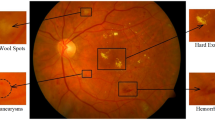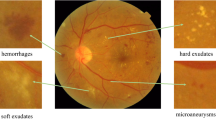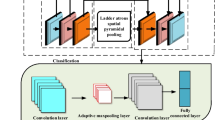Abstract
Diabetic retinopathy (DR) is a common retinal complication led by diabetes over the years, considered a cause of vision loss. Its timely identification is crucial to prevent blindness, requiring expert humans to analyze digital color fundus images. Hence, it is a time-consuming and expensive process. In this study, we propose a model named Attention-DenseNet for detecting and severity grading of DR. We apply a pre-trained convolutional neural network to extract features and get a hierarchical representation of color fundus images. What is essential for the correct diagnosis of DR is to recognize all the retinal lesions and discriminative regions. However, convolutional neural networks may overlook some tiny lesions of color fundus images. So, we use an attention model to solve this issue, which helps the model focus more on distinctive areas than others. We use APTOS 2019 dataset and fivefold cross-validation to assess the model's performance. The method achieves an overall accuracy of 98.44%, an area under receiver operating characteristic curve of 99.55%, and quadratic weighted kappa of 96.88% for the detection task, and an overall accuracy of 83.69%, an area under receiver operating characteristic curve of 97%, and quadratic weighted kappa of 89.26% for grading task. Our experimental results indicate that the model is superior to recent studies and can be suitable for DR classification in real life, especially for DR detection.









Similar content being viewed by others
Data availability
The APTOS 2019 dataset analyzed during the current study is publicly available at https://www.kaggle.com/c/aptos2019-blindness-detection.
Code availability
The code files supporting our published claims are in supplementary files.
References
Alghadyan AA (2011) Diabetic retinopathy: an update. Saudi J Ophthalmol 25:99–111
Faust O, Acharya UR, Ng EYK et al (2012) Algorithms for the automated detection of diabetic retinopathy using digital fundus images: a review. J Med Syst 36:145–157. https://doi.org/10.1007/s10916-010-9454-7
Wang X, Lu Y, Wang Y, Chen WB (2018) Diabetic retinopathy stage classification using convolutional neural networks. In: Proceedings: 2018 IEEE 19th international conference on information reuse and integration for data science, IRI 2018. Institute of Electrical and Electronics Engineers Inc., pp 465–471
Li X, Pang T, Xiong B et al (2018) Convolutional neural networks based transfer learning for diabetic retinopathy fundus image classification. In: Proceedings: 2017 10th international congress on image and signal processing, biomedical engineering and informatics, CISP-BMEI 2017. Institute of Electrical and Electronics Engineers Inc., pp 1–11
Bahdanau D, Cho KH, Bengio Y (2014) Neural machine translation by jointly learning to align and translate. In: 3rd international conference on learning representations, ICLR 2015–conference track proceedings
Xu K, Ba J, Kiros R et al (2015) Show, attend and tell: neural image caption generation with visual attention, pp 2048–2057
APTOS 2019 Blindness Detection | Kaggle. https://www.kaggle.com/c/aptos2019-blindness-detection. Accessed 1 Jun 2021
Rayudu M, Pendam S, Dasari S (2020) Prediction of severity of non proliferated diabetic retinopathy using machine learning techniques. J Comput Theor Nanosci 17:4219–4222. https://doi.org/10.1166/jctn.2020.9049
Satyananda V, Anithalakshmi KC (2019) Diagnosis of diabetic retinopathy using machine learning techniques and embedded systems. Perspect Commun Embed Signal-Process 2:2566–932. https://doi.org/10.17485/ijst/2015/v8i26/81049
Kanimozhi J, Vasuki P, Roomi SMM (2020) Fundus image lesion detection algorithm for diabetic retinopathy screening. J Ambient Intell Humaniz Comput. https://doi.org/10.1007/s12652-020-02417-w
Huda SMA, Ila IJ, Sarder S et al (2019) An improved approach for detection of diabetic retinopathy using feature importance and machine learning algorithms. In: 2019 7th international conference on smart computing and communications, ICSCC 2019. Institute of Electrical and Electronics Engineers Inc
Chetoui M, Akhloufi MA, Kardouchi M (2018) Diabetic retinopathy detection using machine learning and texture features. In: Canadian conference on electrical and computer engineering. Institute of Electrical and Electronics Engineers Inc
Azer SA (2019) Deep learning with convolutional neural networks for identification of liver masses and hepatocellular carcinoma: A systematic review. World J Gastrointest Oncol 11:1218–1230
Doshi D, Shenoy A, Sidhpura D, Gharpure P (2016) Diabetic retinopathy detection using deep convolutional neural networks. In: 2016 international conference on computing, analytics and security trends (CAST). pp 261–266
Ghosh R, Ghosh K, Maitra S (2017) Automatic detection and classification of diabetic retinopathy stages using CNN. In: 2017 4th international conference on signal processing and integrated networks, SPIN 2017. Institute of Electrical and Electronics Engineers Inc., pp 550–554
Saranya P, Prabakaran S (2020) Automatic detection of non-proliferative diabetic retinopathy in retinal fundus images using convolution neural network. J Ambient Intell Humaniz Comput. https://doi.org/10.1007/s12652-020-02518-6
Hagos MT, Kant S (2019) Transfer learning based detection of diabetic retinopathy from small dataset. arXiv
Gangwar AK, Ravi V (2021) Diabetic retinopathy detection using transfer learning and deep learning. In: Advances in intelligent systems and computing. Springer, pp 679–689
Peng Y, He X, Zhao J (2018) Object-part attention model for fine-grained image classification. IEEE Trans Image Process 27:1487–1500. https://doi.org/10.1109/TIP.2017.2774041
Li R, Zheng S, Duan C et al (2021) Multistage attention ResU-Net for semantic segmentation of fine-resolution remote sensing images. IEEE Geosci Remote Sens Lett. https://doi.org/10.1109/LGRS.2021.3063381
Choe J, Lee S, Shim H (2020) Attention-based dropout layer for weakly supervised single object localization and semantic segmentation. IEEE Trans Pattern Anal Mach Intell. https://doi.org/10.1109/TPAMI.2020.2999099
Vaswani A (2017) Attention Is All You Need arXiv:1706.03762v5. Advances in neural information processing systems, 2017-Decem 5999–6009
Mnih V, Heess N, Graves A et al (2014) Recurrent models of visual attention. In: Advances in neural information processing systems, p 27
Zhao Z, Zhang K, Hao X et al (2019) Bira-net: bilinear attention net for diabetic retinopathy grading
Lin Z, Guo R, Wang Y et al (2018) A framework for identifying diabetic retinopathy based on anti-noise detection and attention-based fusion. In: Lecture notes in computer science (including subseries lecture notes in artificial intelligence and lecture notes in bioinformatics) 11071 LNCS, pp 74–82. https://doi.org/10.1007/978-3-030-00934-2_9/COVER
Li X, Hu X, Yu L et al (2020) CANet: cross-disease attention network for joint diabetic retinopathy and diabetic macular Edema grading. IEEE Trans Med Imaging 39:1483–1493. https://doi.org/10.1109/TMI.2019.2951844
He A, Li T, Li N et al (2021) CABNet: category attention block for imbalanced diabetic retinopathy grading. IEEE Trans Med Imaging 40:143–153. https://doi.org/10.1109/TMI.2020.3023463
Kingma DP, Ba JL (2014) Adam: a method for stochastic optimization. In: 3rd international conference on learning representations, ICLR 2015: conference track proceedings
Ahmad Z (2017) Zafarali Ahmed—Medium. https://medium.com/@zafarali. Accessed 11 Dec 2021
Ben-David A (2008) Comparison of classification accuracy using Cohen’s weighted Kappa. Expert Syst Appl 34:825–832. https://doi.org/10.1016/J.ESWA.2006.10.022
Dondeti V, Bodapati JD, Shareef SN, Naralasetti V (2020) Deep convolution features in non-linear embedding space for fundus image classification. Rev d’Intell Artif 34:307–313. https://doi.org/10.18280/ria.340308
Kassani SH, Kassani PH, Khazaeinezhad R et al (2019) Diabetic retinopathy classification using a modified xception architecture. In: 2019 IEEE 19th international symposium on signal processing and information technology, ISSPIT 2019. Institute of Electrical and Electronics Engineers Inc.
Wang L, Schaefer A (2020) Diagnosing diabetic retinopathy from images of the eye fundus. cs230.stanford.edu
Bodapati JD, Shaik NS, Naralasetti V (2021) Composite deep neural network with gated-attention mechanism for diabetic retinopathy severity classification. J Ambient Intell Humaniz Comput. https://doi.org/10.1007/s12652-020-02727-z
Adriman R, Muchtar K, Maulina N (2021) Performance evaluation of binary classification of diabetic retinopathy through deep learning techniques using texture feature. Procedia Comput Sci 179:88–94. https://doi.org/10.1016/J.PROCS.2020.12.012
Funding
Partial financial support was received from Amirkabir University of Technology (Tehran Polytechnic).
Author information
Authors and Affiliations
Corresponding author
Ethics declarations
Conflict of interest
The authors have no relevant financial or non-financial interests to disclose.
Additional information
Publisher's Note
Springer Nature remains neutral with regard to jurisdictional claims in published maps and institutional affiliations.
Supplementary Information
Below is the link to the electronic supplementary material.
Rights and permissions
Springer Nature or its licensor (e.g. a society or other partner) holds exclusive rights to this article under a publishing agreement with the author(s) or other rightsholder(s); author self-archiving of the accepted manuscript version of this article is solely governed by the terms of such publishing agreement and applicable law.
About this article
Cite this article
Dinpajhouh, M., Seyyedsalehi, S.A. Automated detecting and severity grading of diabetic retinopathy using transfer learning and attention mechanism. Neural Comput & Applic 35, 23959–23971 (2023). https://doi.org/10.1007/s00521-023-09001-1
Received:
Accepted:
Published:
Issue Date:
DOI: https://doi.org/10.1007/s00521-023-09001-1




